Popular categories
Looking for a yarn?

100% Wool
from 4.55 $ /50g
The yarn cost is calculated from the pattern’s smallest size and the yarn’s cheapest product type. Looking for an even better price? You might find it on the DROPS Deals!
Junior
Knitted vest with V-neck and textured pattern for baby and children in DROPS BabyMerino or DROPS BabyAlpaca Silk
DROPS design: Pattern no BM-036-by
Yarn group A
--------------------------------------------------------
Size: 1/3 - 6/9 - 12/18 months (2 - 3/4) years
Finished measurements:
Bust: 44-50-56 (62-68) cm / 17 1/4"-19 3/4"-22" (24½"-26 3/4")
Full length: 26-28-31 (33-36) cm / 10 1/4"-11"-12 1/4" (13"-14 1/4")
Materials: DROPS BABY MERINO from Garnstudio
100-100-100 (100-150) color no 19, gray
Or use:
DROPS BABYALPACA SILK from Garnstudio
100-100-100 (150-150) colour no 8465, medium grey
DROPS CIRCULAR NEEDLE size 3 mm / US 2or3 (60 or 80 cm / 24'' or 32'') - or size needed to get 24 sts x 32 rows in stockinette st = 10 x 10 cm / 4'' x 4''.
DROPS CIRCULAR NEEDLE size 2.5 mm / US 1or2 (60 or 80 cm / 24'' or 32'') - for rib.
DROPS MOTHER-OF-PEARL BUTTONS NO 521: 4 pieces
-------------------------------------------------------
Alternative Yarn – See how to change yarns here
Yarn Groups A to F – Use the same pattern and change the yarn here
Yarn usage using an alternative yarn – Use our yarn converter here
-------------------------------------------------------

100% Wool
from 4.55 $ /50g
The yarn cost is calculated from the pattern’s smallest size and the yarn’s cheapest product type. Looking for an even better price? You might find it on the DROPS Deals!
- English (US/in)
- Česky - not translated
- Dansk
- Deutsch
- Eesti keel
- English (UK/cm)
- Español
- Français
- Íslenska
- Italiano
- Magyar
- Nederlands
- Norsk
- Polski
- Português
- Suomi
- Svenska
- English (UK/cm), Bulgaria
- English (UK/cm), Croatia
- English (UK/cm), Greece
- English (UK/cm), Latvia
- English (UK/cm), Lithuania
- English (UK/cm), Romania
- English (UK/cm), Slovenia
- Česky, Slovakia - not translated
Pattern instructions
DOUBLE SEED ST:
Row 1: * K 2, P 2 *, repeat from *-*.
Row 2: K over K and P over P.
Row 3: P over K and K over P.
Row 4: As row 2.
Repeat row 1 to 4.
BUTTON HOLES:
Bind off for button holes on right band. 1 button hole = K tog 2nd and 3rd st from edge and make 1 YO. Bind off for button holes when piece measures:
SIZE 1/3 MONTHS: 2, 6, 10 and 14 cm / 3/4", 2 3/8", 4" and 5½''.
SIZE 6/9 MONTHS: 2, 7, 11 and 16 cm / 3/4", 2 3/4", 4 3/8" and 6 1/4".
SIZE 12/18 MONTHS: 2, 7, 12 and 17 cm / 3/4", 2 3/4", 4 3/4" and 6 3/4".
SIZE 2 YEARS: 2, 8, 13 and 19 cm / 3/4", 3 1/8", 5 1/8" and 7½".
SIZE 3/4 YEARS: 2, 8, 14 and 20 cm / 3/4", 3 1/8", 5½" and 8".
DEC FOR V-NECK AND ARMHOLES IN DOUBLE SEED ST:
All dec are done from RS!
DEC AS FOLLOWS BEFORE BAND/SLEEVE EDGE:
When last st should be K: K 2 tog.
When last st should be P: P 2 tog.
DEC AS FOLLOWS AFTER BAND/SLEEVE EDGE:
When first st should be K: Slip 1 st as if to K, K 1, psso.
When first st should be P: P 2 twisted tog (i.e. work in back loop of st instead of front).
--------------------------------------------------------
--------------------------------------------------------
BODY:
Worked back and forth on circular needle from mid front.
Cast on 148-168-184 (204-224) sts on circular needle size 2.5 mm / US 1 with Baby Merino. Work first row as follows from RS: 5 sts in GARTER ST (= band) - see explanation above, * K 2, P 2 *, repeat from *-* until 7 sts remain, finish with K 2 and 5 sts in GARTER ST (= band). Continue rib like this with 5 sts in garter st in each side until piece measures 3-3-4 (4-5) cm / 1 1/8"-1 1/8"-1½" (1½"-2") - REMEMBER BUTTON HOLES on band - see explanation above. Switch to circular needle size 3 mm / US 2or3 and work in stockinette st but continue bands in garter st as before. AT THE SAME TIME on first row after rib, dec 32-36-40 (44-52) sts evenly (do not dec over bands) = 116-132-144 (160-172) sts. Insert a marker 31-35-39 (43-45) sts in from each side (= 54-62-66 (74-82) sts between markers on back piece). REMEMBER THE GAUGE! When piece measures 7-7½-8 (9-10) cm / 2 3/4"-2 7/8"-3 1/8" (3½"-4"), work next row as follows from RS: 5 sts in garter st, 21-21-27 (27-31) sts in stockinette st, slip the last 16-16-20 (20-24) sts that were worked on a stitch holder for pocket slit, work until 10-10-12 (12-12) sts remain on needle, slip the last 16-16-20 (20-24) sts that were worked on a stitch holder for pocket slit, work 5-5-7 (7-7) sts in stockinette st and finish with 5 sts in garter st. On next row cast on 16-16-20 (20-24) new sts over each of the 2 stitch holders with sts = 116-132-144 (160-172) sts. Continue in stockinette st and in garter st until piece measures 13-14-16 (16-18) cm / 5 1/8"-5½"-6 1/4" (6 1/4"-7"). Now K 4 rows over all sts (= 2 ridges). Then work DOUBLE SEED ST - see explanation above (continue bands in garter st as before). READ ALL OF THE FOLLOWING SECTION BEFORE CONTINUING! When piece measures 15-17-18 (20-21) cm / 6"-6 3/4"-7" (8"-8 1/4"), work 2 rows in garter st over the first 5 sts on needle (do not work the other sts on needle), then work 1 row over all sts before working 2 rows in garter st over the first 5 sts on needle in the other side of piece (this is done so that the V-neck looks nice). Then dec for V-neck - see explanation above: Dec 1 st every other row (i.e. every row from RS) a total of 12-13-16 (16-16) times. AT THE SAME TIME when piece measures 16-17-19 (20-22) cm / 6¼''-6¾''-7½'' (8''-8¾''), work 4 rows in garter st over the middle 18-20-20 (20-20) sts in each side (i.e. over 9-10-10 (10-10) sts on each side of both markers) – work the other sts as before. On next row, bind off the middle 8-10-10 (10-10) sts in each side for armhole and finish front and back piece separately.
BACK PIECE:
= 46-52-56 (64-72) sts. Work double seed st with 5 sts in garter st in each side (= sleeve edges). AT THE SAME TIME dec for armholes - see explanation above: Dec 1 st every other row (i.e. on every row from RS) a total of 5-6-6 (6-6) times = 36-40-44 (52-60) sts. Continue in double seed st and in garter st until piece measures 24-26-29 (31-34) cm / 9½"-10 1/4"-11 3/8" (12 1/4"-13 3/8"). Now work in garter st over all sts until finished measurements. AT THE SAME TIME when piece measures 25-27-30 (32-35) cm / 9 3/4"-10 5/8"-11 3/4" (12½"-13 3/4"), bind off the middle 16-18-20 (20-24) sts for neck = 10-11-12 (16-18) sts remain on each shoulder. Now finish each shoulder separately. Continue with garter st until piece measures 26-28-31 (33-36) cm / 10 1/4"-11"-12 1/4" (13"-14 1/4"), bind off.
LEFT FRONT PIECE:
Continue with double seed st and in garter st while AT THE SAME TIME dec for armhole in the side as on back piece and continue dec for V-neck as before. After last dec, 10-11-12 (16-18) sts remain on needle. Work garter st over all sts until piece measures 26-28-31 (33-36) cm / 10 1/4"-11"-12 1/4" (13"-14 1/4") and bind off.
RIGHT FRONT PIECE:
Work as left front piece but reversed.
POCKET FLAP:
Slip the 16-16-20 (20-24) sts from stitch holder on one front piece back on needle size 2.5 mm / US 1or2. Work rib K2/P2 with 1 st in garter st and K 2 in each side (seen from RS).
When pocket flap measures 2½-2½-3 (3-3) cm / 7/8"-7/8"-1 1/8" (1 1/8"-1 1/8"), loosely bind off with K over K and P over P.
Sew pocket flap to front piece with duplicate sts in each side. Sew pocket opening to bottom of pocket flap (where sts were put on a stitch holder) on the back of piece. Work another pocket flap the same way on the other front piece.
ASSEMBLY:
Sew the shoulder seams. Sew on buttons.
Diagram
All measurements in charts are in cm.
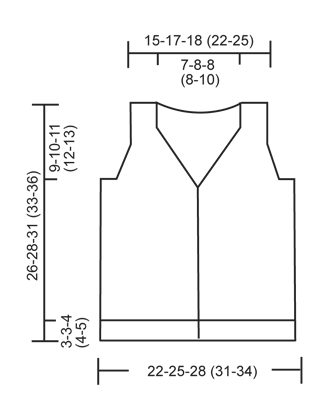
What can you do with our patterns? You can share DROPS patterns online, using the pattern original picture, materials, name and number. But you are NOT ALLOWED to reproduce the complete pattern digitally in any way. Yarn stores are welcome to use the DROPS pattern database to promote the sale of our assortment. You can print out our patterns, make as many copies as you’d like. The only thing we ask is that you don't make any changes / additions to the original printed document. And that the patterns according to the DROPS philosophy are given out to the consumers for free. Editorials that wish to publish our patterns in printed books or magazines can contact us for more information. The sale of garments based on DROPS patterns is permitted as long as they are sold as single items or per order. Further commercial use of the patterns is not permitted. It has to be clearly stated that the garment is made based on a design from DROPS DESIGN. The use of clothing labels of which DROPS DESIGN forms part is conditioned by the inclusion of the following text: “A DROPS DESIGN made by …..”. The use of DROPS photos for marketing purposes/sales is only permitted in connection with the use/sale of DROPS products. The photos may not be cut or edited and the logo should be clearly visible.
We reserve the right to withdraw the permission for use of our patterns at any time, notwithstanding the reason.
Each of our patterns has specific tutorial videos to help you.
These step-by-step tutorials might also help you:
Why is the knitting/crochet tension so important?
Knitting tension is what determines the final measurements of your work, and is usually measured per 10 x 10 cm. It is provided like so: number of stitches in width x number of rows in height - eg: 19 stitches x 26 rows = 10 x 10 cm.
The knitting tension is very individual; some people knit/crochet loosely while others work tightly. You adjust the knitting tension with the needle size, which is why the suggested needle size only serve as a guide! You need to adjust this (up or down) to ensure that YOUR knitting tension matches the knitting tension provided in the pattern. If you work with a different knitting tension than provided you will have a different yarn consumption, and your work will have different measurements than what the pattern suggests.
The knitting tension also determines which yarns can replace each other. As long as you achieve the same knitting tension you can replace one yarn with another.
See DROPS lesson: How to measure your tension/gauge
See DROPS video: How to make a gauge tension swatch
How do I know how many balls of yarn I need?
The required amount of yarn is provided in grams, eg: 450 g. To calculate how many balls you’ll need you first need to know how many grams are in 1 ball (25g, 50g or 100g). This information is available if you click on the individual yarn quality on our pages. Divide the amount required with the amount of each ball. For example, if each ball is 50g (the most common amount), the calculation will be as follows: 450 / 50 = 9 balls.
Can I use a different yarn than what the pattern suggests?
The important thing when changing from one yarn to another is that the knitting/crochet tension remains the same. This is so that the measurements of the finished piece will be the same as on the sketch provided. It is easier to achieve the same knitting tension using yarns from the same yarn group. It is also possible to work with multiple strands of a thinner yarn to achieve the knitting tension of a thicker one. Please try our yarn converter. We recommend you to always work a test swatch.
Please NOTE: when changing yarn the garment might have a different look and feel to the garment in the photo, due to individual properties and qualities of each yarn.
See DROPS lesson: Can I use a different yarn than the one mentioned in the pattern?
What are the yarn groups?
All our yarns are categorised into yarn groups (from A to F) according to thickness and knitting tension – group A contains the thinnest yarns and group F the thickest. This makes it easier for you to find alternative yarns to our patterns, should you wish to switch yarn. All yarns within the same group have a similar knitting tension and can easily replace each other. However, different yarn qualities have different structures and properties which will give the finished work a unique look and feel.
How do I use the yarn converter?
At the top of all our patterns you’ll find a link to our yarn converter, which is a helpful tool should you wish to use a different yarn than suggested. By filling in the yarn quality you wish to replace, the amount (in your size) and number of strands, the converter will present good alternative yarns with the same knitting tension. Additionally it will tell you how much you’ll require in the new qualities and whether you’ll need to work with multiple strands. Most skeins are 50g (some are 25g or 100g).
If the pattern is worked with multiple colours, every colour will have to be converted separately. Similarly, if the pattern is worked with several strands of different yarns (for example 1 strand Alpaca and 1 strand Kid-Silk) you will have to find alternatives for each, individually.
Why do you show discontinued yarns in the patterns?
Since different yarns have different qualities and textures we have chosen to keep the original yarn in our patterns. However, you can easily find options among our available qualities by using our yarn converter, or simply pick a yarn from the same yarn group.
It is possible that some retailers still have discontinued yarns in stock, or that someone has a few skeins at home that they would like to find patterns for.
The yarn converter will provide both alternative yarn as well as required amount in the new quality.
What size should I knit?
If you think it's hard to decide what size to make, it can be a good idea to measure a garment you own already and like the size of. Then you can pick the size by comparing those measures with the ones available in the pattern's size chart.
You'll find the size chart at the bottom of the pattern.
See DROPS lesson: How to read size chart
Why do I get the wrong knitting tension with the suggested needle size?
The needle size provided in the pattern serves only as a guide, the important thing is to follow the knitting tension. And since knitting tension is very individual, you will have to adjust the needle size to ensure that YOUR tension is the same as in the pattern – maybe you’ll have to adjust 1, or even 2 needle sizes, up or down to achieve the correct tension. For this, we recommend that you work test swatches.
Should you work with a different knitting tension than the one provided, the measurements of the finished garment might deviate from the measurement sketch.
See DROPS lesson: How to measure your tension/gauge
See DROPS video: How to make a gauge tension swatch
Why is the pattern worked top-down?
Working a garment top-down provides more flexibility and room for personal adjustment. For example it is easier to try the garment on while working, as well as making adjustments to length of yoke and shoulder caps.
The instructions are carefully explaining every step, in the correct order. Diagrams are adjusted to the knitting direction and are worked as usual.
How do I work according to a knitting diagram?
The diagram depicts all rows/rounds, and every stitch seen from the right side. It is read from bottom to top, from right to left. 1 square = 1 stitch.
When working back and forth, every other row is worked from the right side and every other row is worked from the wrong side. When working from the wrong side, the diagram will have to be worked reversed: from left to right, knit stitches are purled, purl stitches are knit etc.
When working in the round every round is worked from the right side and the diagram are worked from right to left on all rounds.
See DROPS lesson: How to read knitting diagrams
How do I work according to a crochet diagram?
The diagram depicts all rows/rounds, and every stitch seen from the right side. It is worked from bottom to top, from right to left.
When working back and forth every other row is worked from the right side: from right to left and every other row is worked from the wrong side: from left to right.
When working in the round, every row in the diagram are worked from the right side, from right to left.
When working a circular diagram you start in the middle and work your way outwards, counter clockwise, row by row.
The rows usually start with a given number of chain stitches (equivalent to the height of the following stitch), this will either be depicted in the diagram or explained in the pattern.
See DROPS lesson: How to read crochet diagrams
How do I work several diagrams simultaneously on the same row/round?
Instructions for working several diagrams after each other on the same row/round, will often be written like so: “work A.1, A.2, A.3 a total of 0-0-2-3-4 times". This means you work A.1 once, then A.2 is worked once, and A.3 is repeated (in width) the number of times provided for your size – in this case like so: S = 0 times, M = 0 times, L=2 times, XL= 3 times and XXL = 4 times.
The diagrams are worked as usual: begin with the first row in A.1, then work the first row in A.2 etc.
See DROPS lesson: How to read knitting diagrams
See DROPS lesson: How to read crochet diagrams
Why are the sleeves shorter in larger sizes?
The total width of the garment (from wrist-to-wrist) will be larger in the larger sizes, despite the actual sleeves being shorter. The larger sizes have longer sleeve caps and wider shoulders, so there will be a good fit in all sizes.
Where on the garment is the length measured?
The measurement sketch/schematic drawing provides information regarding the full length of the garment. If it’s a jumper or a jacket the length is measured from the highest point on the shoulder (usually closest to the neckline), and straight down to the bottom of the garment. It is NOT measured from the tip of shoulder. Similarly, the length of yoke is measured from the highest point on the shoulder and down to where yoke is split into body and sleeves.
See DROPS lesson: How to read a schematic drawing
What is a repeat?
Diagrams are often repeated on the round or in height. 1 repeat is the diagram the way it appears in the pattern. If it says to work 5 repeats of A.1 in the round, then you work A.1 a total of 5 times after/next to each other in the round. If it says to work 2 repeats of A.1 vertically/in height you work the entire diagram once, then begin again at the start and work the entire diagram one more time.
Why does the piece start with more chain stitches than it’s worked with?
Chain stitches are slightly narrower than other stitches and to avoid working the cast-on edge too tight, we simply chain more stitches to begin with. The stitch count will be adjusted on the following row to fit the pattern and measurement sketch.
Why increase before the rib edge when the piece is worked top-down?
The rib edge is more elastic and will contract slightly compared to, for example, stocking stitch. By increasing before the rib edge, you avoid a visible difference in width between the rib edge and the rest of the body.
Why increase in the cast-off edge?
It’s very easy to cast off too tightly, and by making yarn overs while casting off (and simultaneously casting these off) you avoid a too tight cast off edge.
See DROPS video: How to bind off with yarn overs (yo)
How do I increase/decrease on every 3rd and 4th row/round alternately?
To achieve an even increase (or decrease) you can increase on, for example: every 3rd and 4th row alternately, like so: work 2 rows and increase on the 3rd row, work 3 rows and increase on the 4th. Repeat this until the increase is complete.
See DROPS lesson: Increase or decrease 1 st on every 3rd and 4th row alternately
How can I work a jacket in the round instead of back and forth?
Should you prefer to work in the round instead of back and forth, you may of course adjust the pattern. You’ll need to add steeks mid-front (usually 5 stitches), and follow the instructions. When you would normally turn and work from the wrong side, simply work across the steek and continue in the round. At the end you’ll cut the piece open, pick up stitches to work bands, and cover the cut edges.
See DROPS video: How to knit steeks and cut open
Can I work a jumper back and forth instead of in the round?
Should you prefer to work back and forth instead of in the round, you may of course adjust the pattern so you work the pieces separately and then assemble them at the end. Divide the stitches for the body in 2, add 1 edge stitch in each side (for sewing) and work the front and back pieces separately.
See DROPS lesson: Can I adapt a pattern for circular needles into straight needles?
Why is the pattern slightly different than what I see in the photo?
Pattern repeats can vary slightly in the different sizes, in order to get the correct proportions. If you’re not working the exact same size as the garment in the photo, yours might deviate slightly. This has been carefully developed and adjusted so that the complete impression of the garment is the same in all sizes.
Make sure to follow instructions and diagrams for your size!
How do I make a women’s size garment into a men’s size one?
If you have found a pattern you like which is available in women’s size it’s not very difficult to convert it to men’s size. The biggest difference will be the length of sleeves and body. Start working on the women size that you think would fit across the chest. The additional length will be worked right before you cast off for the armhole/sleeve cap. If the pattern is worked top-down you can add the length right after the armhole or before the first decrease on sleeve.
Regarding additional yarn amount, this will depend on how much length you add, but it is better with a skein too many than too few.
How do I prevent a hairy garment from shedding?
All yarns will have excess fibres (from production) that might come off as lint or shedding. Brushed yarns (ie hairier yarns) have more of these loose, excess fibres, causing more shedding.
Shedding also depends on what is worn under or over the garment, and whether this pulls at the yarn fibres. It’s therefore not possible to guarantee that there will be no shedding
Below are some tips on how to get the best result when working with hairier yarns:
1. When the garment is finished (before you wash it) shake it vigorously so the looser hairs come off. NOTE: do NOT use a lint roller, brush or any method that pulls at the yarn.
2. Place the garment in a plastic bag and put it in your freezer - the temperature will cause the fibres to become less attached to each other, and excess fibres will come off easier.
3. Leave in the freezer for a few hours before taking it out and shaking it again.
4. Wash the garment according to the instructions on the yarn label.
Why does my garment pill?
Pilling is a natural process that happens to even the most exclusive of fibers. It's a natural sign of wear and tear that is hard to avoid, and that is most visible in high friction areas of your garment like a sweater's arms and cuffs.
You can make your garment look as new by removing the pilling, using a fabric comb or a pill/lint remover.
In the meantime, you can read the questions and answers that others have left to this pattern or join the DROPS Workshop on Facebook to get help from fellow knitters/crocheters!
You might also like...
Junior
Little gentleman
Mit bedste tip må være #givaldrigop og hver tro mod dig selv..
Junior |
|
 |
 |
Knitted vest with V-neck and textured pattern for baby and children in DROPS BabyMerino or DROPS BabyAlpaca Silk
DROPS Baby 21-8 |
|
|
GARTER ST (back and forth on needle): K all rows. DOUBLE SEED ST: Row 1: * K 2, P 2 *, repeat from *-*. Row 2: K over K and P over P. Row 3: P over K and K over P. Row 4: As row 2. Repeat row 1 to 4. BUTTON HOLES: Bind off for button holes on right band. 1 button hole = K tog 2nd and 3rd st from edge and make 1 YO. Bind off for button holes when piece measures: SIZE 1/3 MONTHS: 2, 6, 10 and 14 cm / 3/4", 2 3/8", 4" and 5½''. SIZE 6/9 MONTHS: 2, 7, 11 and 16 cm / 3/4", 2 3/4", 4 3/8" and 6 1/4". SIZE 12/18 MONTHS: 2, 7, 12 and 17 cm / 3/4", 2 3/4", 4 3/4" and 6 3/4". SIZE 2 YEARS: 2, 8, 13 and 19 cm / 3/4", 3 1/8", 5 1/8" and 7½". SIZE 3/4 YEARS: 2, 8, 14 and 20 cm / 3/4", 3 1/8", 5½" and 8". DEC FOR V-NECK AND ARMHOLES IN DOUBLE SEED ST: All dec are done from RS! DEC AS FOLLOWS BEFORE BAND/SLEEVE EDGE: When last st should be K: K 2 tog. When last st should be P: P 2 tog. DEC AS FOLLOWS AFTER BAND/SLEEVE EDGE: When first st should be K: Slip 1 st as if to K, K 1, psso. When first st should be P: P 2 twisted tog (i.e. work in back loop of st instead of front). -------------------------------------------------------- -------------------------------------------------------- BODY: Worked back and forth on circular needle from mid front. Cast on 148-168-184 (204-224) sts on circular needle size 2.5 mm / US 1 with Baby Merino. Work first row as follows from RS: 5 sts in GARTER ST (= band) - see explanation above, * K 2, P 2 *, repeat from *-* until 7 sts remain, finish with K 2 and 5 sts in GARTER ST (= band). Continue rib like this with 5 sts in garter st in each side until piece measures 3-3-4 (4-5) cm / 1 1/8"-1 1/8"-1½" (1½"-2") - REMEMBER BUTTON HOLES on band - see explanation above. Switch to circular needle size 3 mm / US 2or3 and work in stockinette st but continue bands in garter st as before. AT THE SAME TIME on first row after rib, dec 32-36-40 (44-52) sts evenly (do not dec over bands) = 116-132-144 (160-172) sts. Insert a marker 31-35-39 (43-45) sts in from each side (= 54-62-66 (74-82) sts between markers on back piece). REMEMBER THE GAUGE! When piece measures 7-7½-8 (9-10) cm / 2 3/4"-2 7/8"-3 1/8" (3½"-4"), work next row as follows from RS: 5 sts in garter st, 21-21-27 (27-31) sts in stockinette st, slip the last 16-16-20 (20-24) sts that were worked on a stitch holder for pocket slit, work until 10-10-12 (12-12) sts remain on needle, slip the last 16-16-20 (20-24) sts that were worked on a stitch holder for pocket slit, work 5-5-7 (7-7) sts in stockinette st and finish with 5 sts in garter st. On next row cast on 16-16-20 (20-24) new sts over each of the 2 stitch holders with sts = 116-132-144 (160-172) sts. Continue in stockinette st and in garter st until piece measures 13-14-16 (16-18) cm / 5 1/8"-5½"-6 1/4" (6 1/4"-7"). Now K 4 rows over all sts (= 2 ridges). Then work DOUBLE SEED ST - see explanation above (continue bands in garter st as before). READ ALL OF THE FOLLOWING SECTION BEFORE CONTINUING! When piece measures 15-17-18 (20-21) cm / 6"-6 3/4"-7" (8"-8 1/4"), work 2 rows in garter st over the first 5 sts on needle (do not work the other sts on needle), then work 1 row over all sts before working 2 rows in garter st over the first 5 sts on needle in the other side of piece (this is done so that the V-neck looks nice). Then dec for V-neck - see explanation above: Dec 1 st every other row (i.e. every row from RS) a total of 12-13-16 (16-16) times. AT THE SAME TIME when piece measures 16-17-19 (20-22) cm / 6¼''-6¾''-7½'' (8''-8¾''), work 4 rows in garter st over the middle 18-20-20 (20-20) sts in each side (i.e. over 9-10-10 (10-10) sts on each side of both markers) – work the other sts as before. On next row, bind off the middle 8-10-10 (10-10) sts in each side for armhole and finish front and back piece separately. BACK PIECE: = 46-52-56 (64-72) sts. Work double seed st with 5 sts in garter st in each side (= sleeve edges). AT THE SAME TIME dec for armholes - see explanation above: Dec 1 st every other row (i.e. on every row from RS) a total of 5-6-6 (6-6) times = 36-40-44 (52-60) sts. Continue in double seed st and in garter st until piece measures 24-26-29 (31-34) cm / 9½"-10 1/4"-11 3/8" (12 1/4"-13 3/8"). Now work in garter st over all sts until finished measurements. AT THE SAME TIME when piece measures 25-27-30 (32-35) cm / 9 3/4"-10 5/8"-11 3/4" (12½"-13 3/4"), bind off the middle 16-18-20 (20-24) sts for neck = 10-11-12 (16-18) sts remain on each shoulder. Now finish each shoulder separately. Continue with garter st until piece measures 26-28-31 (33-36) cm / 10 1/4"-11"-12 1/4" (13"-14 1/4"), bind off. LEFT FRONT PIECE: Continue with double seed st and in garter st while AT THE SAME TIME dec for armhole in the side as on back piece and continue dec for V-neck as before. After last dec, 10-11-12 (16-18) sts remain on needle. Work garter st over all sts until piece measures 26-28-31 (33-36) cm / 10 1/4"-11"-12 1/4" (13"-14 1/4") and bind off. RIGHT FRONT PIECE: Work as left front piece but reversed. POCKET FLAP: Slip the 16-16-20 (20-24) sts from stitch holder on one front piece back on needle size 2.5 mm / US 1or2. Work rib K2/P2 with 1 st in garter st and K 2 in each side (seen from RS). When pocket flap measures 2½-2½-3 (3-3) cm / 7/8"-7/8"-1 1/8" (1 1/8"-1 1/8"), loosely bind off with K over K and P over P. Sew pocket flap to front piece with duplicate sts in each side. Sew pocket opening to bottom of pocket flap (where sts were put on a stitch holder) on the back of piece. Work another pocket flap the same way on the other front piece. ASSEMBLY: Sew the shoulder seams. Sew on buttons. |
|

|
|
|
Have you made this or any other of our designs? Tag your pictures in social media with #dropsdesign so we can see them! Do you need help with this pattern?You'll find tutorial videos, a Comments/Questions area and more by visiting the pattern on garnstudio.com. © 1982-2024 DROPS Design A/S. We reserve all rights. This document, including all its sub-sections, has copyrights. Read more about what you can do with our patterns at the bottom of each pattern on our site. |
|
With over 40 years in knitting and crochet design, DROPS Design offers one of the most extensive collections of free patterns on the internet - translated to 17 languages. As of today we count 304 catalogs and 11422 patterns - 11417 of which are translated into English (US/in).
We work hard to bring you the best knitting and crochet have to offer, inspiration and advice as well as great quality yarns at incredible prices! Would you like to use our patterns for other than personal use? You can read what you are allowed to do in the Copyright text at the bottom of all our patterns. Happy crafting!













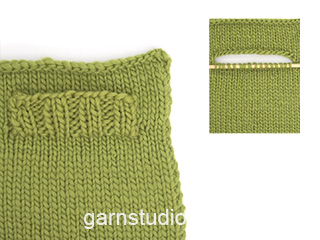
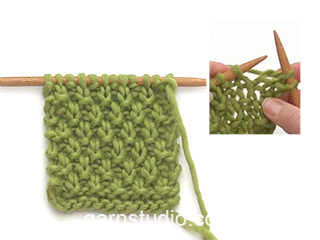




























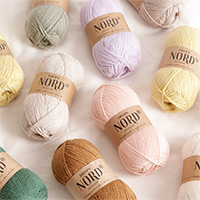
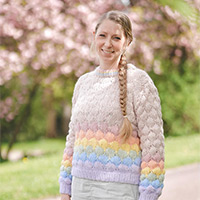
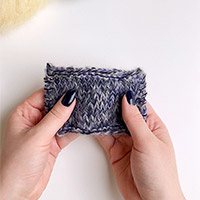


Comments / Questions (208)
Het spencertje is hartstikke leuk geworden ..alleen begrijp ik de toegevoegde waarde van de rondbrei nld niet! Dit maakt het breien extra lastig ... Mijn inzien had het ook op een rechte nld gekund ... Compliment voor het patroon.
01.09.2015 - 10:35Vandana wrote:
Want to make 2 yr. But my gauge is 6.8 st per 1 inch / 2.5 cms. If I make 3-4 yr size, will it be around size required for 2 yr?
10.08.2015 - 06:53DROPS Design answered:
Dear Vandana, pattern is written with a tension of 24 sts x 32 rows in stockinette st = 4" x 4" - try with smaller needle or adapt / adjust to your tension and following the measurement chart. Happy knitting!
10.08.2015 - 10:44Hej Drops. I str 12/18 er jeg nået til at tage ind til v-hals. Der står at jeg skal tage 1 m ind på hver 2. p. Men hvor i arbejdet? Jeg er også i tvivl om, hvordan jeg skal strikke 4p retstrik over de midterste masker, når jeg ikke har delt arbejdet endnu. Kan I hjælpe?
26.07.2015 - 08:36DROPS Design answered:
Hej Marie, du tager ind til V-hals indenfor de 5 kantm mod midt foran. Når du strikker hele stykket frem og tilbage så strikker du de 9-10-x-x m på hver side af mærketråden i retstrik. Når du har strikket 4 pinde mere lukker du de midterste 8-10-x-x m af til ærmegab (4-5-x-x på hver side af mærketråden) og fortsætter med stykkerne hver for sig. God fornøjelse!
28.07.2015 - 13:32Selam wrote:
RS: 5 sts in gr.st, (31) sts in stocking st, slip the last 24) sts that were worked on a stitch holder for pocket slit, work until 12) sts remain on needle, slip the last 24) sts that were worked on a stitch holder for pocket slit, 7) sts in stocking st and finish with 5 sts in garter st. I have difficulty understanding this INSTRUCTION im working on largets size. i have 5 in garter st.then 40 sts before the marker.etc I have nothing being worked on on a stich holder.please explain better.
24.06.2015 - 09:07DROPS Design answered:
Dear Selam, work opening for pockets as follows: 5 sts in garter st, work 31 sts in stocking st, slip the last 24 sts that were worked on a stitch holder for pocket slit (= 7 sts remain on the needle = you work 7 sts in stocking st, then 24 sts and put these 24 sts on a thread). See also video below (with another number of sts but technique is the same). Happy knitting!
24.06.2015 - 09:17Mariana Quillehauquy wrote:
Me equivoco o la parte donde dice cuerso tiene un error dice 164 puntos es mucho para un niño de 2 años
04.05.2015 - 03:21DROPS Design answered:
Hola Mariana, los pts son correctos. El cuerpo se trabaja con 160 pts. Tensión de la muestra 24 pts = 10 cm; 160pts = aprox 65 cm, que se corresponden con las medidas del cuerpo en el diagrama de abajo (31 cm x 2 lados + la cenefa que se monta encima).
04.05.2015 - 10:29Buon giorno. Sono in difficoltà a capire come effettuare le diminuzione per lo scalfo della manica. Nella spiegazione si parla di prima e dopo il bordo dei 5 punti a maglia legaccio, ma "Diminuire come segue dopo il bordo. Quando l'ultima maglia..." ma quale ultima maglia che sono all'inizio del ferro? L'ultima delle due che devo lavorare insieme? Grazie.
25.03.2015 - 09:32DROPS Design answered:
Buongiorno Silvia. Abbiamo corretto il testo: il riferimento è alla prima m e non all’ultima. La ringraziamo per la segnalazione. Buon lavoro!
25.03.2015 - 09:47Baasiq wrote:
Sliczny wzor. czy mozna prosic o przetlumaczenie na jezyk polski. pozdrawiam
14.03.2015 - 16:48DROPS Design answered:
Oczywiście, w ciągu tygodnia znajdzie się na stronie. POZDRAWIAMY
14.03.2015 - 17:03Bonjour je ne comprends pas les explications à partir de 19cm de hauteur totale il faut faire 4 rangs de point mousse au dessus des 20mailles centrale soit 10 mailles de chaque cote de chaque marqueur je ne vois pas comment faire pouvez-vous me guider pas à pas en me disant quoi faire sur ce rang. Merci
06.03.2015 - 00:32DROPS Design answered:
Bonjour Mme Wu, à 19 cm (taille 12/18 mois), on va former la bordure sous les bras en tricotant 4 rangs point mousse sur les 20 m des côtés (soit 10 m avant + 10 m après chacun des marqueurs). Tricotez ces 4 rangs comme avant sur les autres mailles. Au rang suivant, on rabat les 10 m au milieu de ces 20 m (= il reste 5 m point mousse de bordure d'emmanchure pour chaque devant et de chaque côté pour le dos). Bon tricot!
06.03.2015 - 09:17Bonjour. En 6/9 mois je ne comprends pas les diminutions à 17cm de haut. Avant la séparation en 3,il y a 13 diminutions tous les 2 rangs. Une fois les 3 parties séparées, pour le dos les diminutions de 6 x 1 m tous les 2 rangs nous fait diminuer 12 m(de 52 à 40 mailles), ce qui fait 6 x 2m sur chaque rang diminué. Pour les 2 autres parties, on continue les diminutions comme avant mais on doit se retrouver à 11 m. Comment répartir les diminutions ?Merci d’avance
20.02.2015 - 00:15DROPS Design answered:
Bonjour Noémie, les diminutions de l'encolure commencent après les 2 rangs point mousse sur les 5 m de chaque côté (rangs raccourcis), on diminue 13 fois 1 m tous les 2 rangs au total, mais en même temps, (à 17 cm également), vous tricotez 4 rangs point mousse sur les 20 m de chaque côté pour les emmanchures, rabattez les mailles des emmanchures et continuez chaque partie séparément en continuant les diminutions de l'encolure. Bon tricot!
20.02.2015 - 09:09Die Abnahmen im Perlmuster sind mir nicht ganz klar. Es ist erklärt was zu tun ist wenn die ersten/letzten Maschen vor den Blenden zwei rechte oder zwei linke Maschen sind. Wie nehme ich denn in der Reihe danach ab wenn eine rechts und die andere links ist? Danke für Eure Hilfe!
17.02.2015 - 01:58DROPS Design answered:
Liebe Stina, leider ist bei der Übersetzung ein Fehler passiert. Die Anleitung wurde nun korrigiert, jetzt sagt die Erklärung, wie Sie die M abnehmen müssen.
23.02.2015 - 10:04